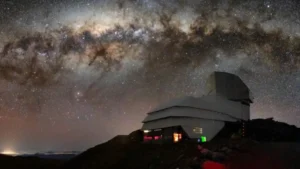A solar storm is expected to summon the northern lights further south than usual today.
Energetic auroras are more than likely over Alaska, most of Canada, and other northern regions. But its intensity could spark hours of auroras from the Arctic Circle to the northern U.S., reaching as far south as Maine and New York, according to the NOAA.
Experts suggest finding a dark skies location away from city lights to catch sight of the event. The spectacle will likely occur low on the horizon, even in cloudy conditions.

Solar flares eject vast amounts of radiation. Photo: NASA/Shutterstock
Solar storms and the aurora borealis
Formally, the storm has been assigned a moderate G2 intensity rating on a scale that slides from G1 (least intense) to G5 (catastrophic). The impact that a G2 geomagnetic storm has on Earth fluctuates on a storm-by-storm basis. The fiercest examples have downed power grids and radio and satellite communications. Those instances also catalyze strong auroral responses even closer to the equator than the current storm.
This week’s space weather doesn’t fall within the extreme range of G2s, though experts say that spacecraft and northerly power systems will experience some fluctuations.
These storms result from coronal mass ejections, also known as solar flares, which expel charged particles. The Earth’s magnetic poles pull on the particles that reach our atmosphere. Their polar trajectory causes the particles to shed energy, which, in this case, is emitted in the form of the northern lights.
Some extra credit: ‘aurora borealis’ is a term reserved for lights emitted by particles drawn to the North Pole. Lights emitted by particles at the South Pole are referred to as ‘aurora australis,’ otherwise known as the southern lights.
The magnetic pull that causes the light emission is strongest at Earth’s poles and grows weaker at latitudes further away from each pole. Since the equator is the strip of Earth that’s furthest from the poles, auroras rarely appear in its atmosphere. There are no documented instances of northern lights reaching as far south as the equator. In 1921, the southern lights appeared 13° below the equator. It remains the only known instance of equatorial aurora australis.
Refer to our previous write-up here for an in-depth explanation of solar cycles, flares, and geomagnetic storms.






